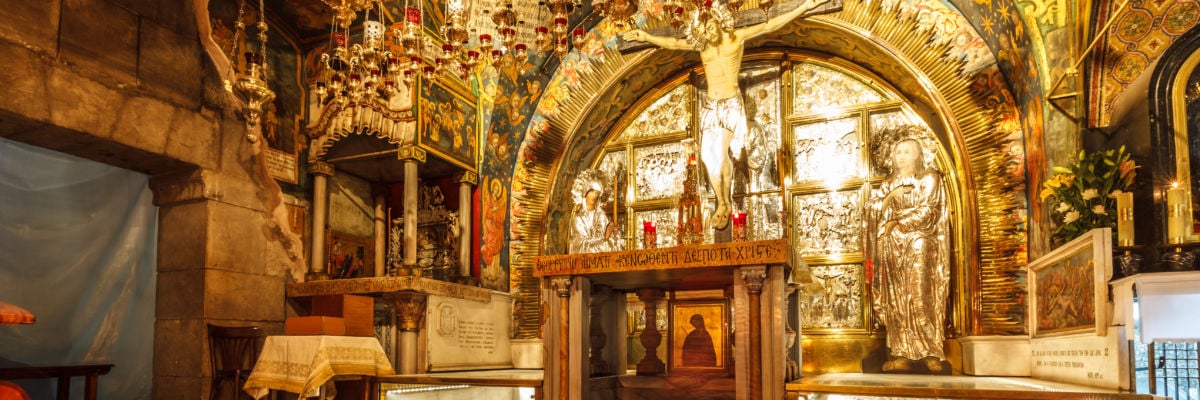
And God said, “Remove the sandals from your feet, for the place where you stand is holy ground.”
Holy ground? What holy ground? This was a harsh wilderness. Vultures circled above during the day, and hyenas prowled at night. There were no church steeples rising into the sky—no prophet or priests worshiping here. Moses was tending sheep among the rocks under the hot sun. Why take off his sandals in the rocky wilds?
While stepping over stones and weaving through scrubby plants, Moses had seen a burning bush—but that was not unusual. What intrigued Moses was that the bush was engulfed in flame, but it was not consumed. He turned aside to see this “great sight.” As he approached the fire, God called out from the bush. God told Moses that he was standing on “holy ground.”
This was the wilderness of Sinai, far from the Promised Land to the north. For Moses, this was a land of exile. How could such rugged ground be holy? What makes ground holy?
Yes, holy means sinless, but it also means “set apart”—consecrated or special. Rocks and dirt and desert scrub cannot be thought of as sinless so God must have meant the second definition. This piece of land was somehow sacred, special or different from the dirt and rocks a few yards away. Why?
The footprints of God, so to speak, had touched this ground in space and time. He had come down from heaven, condescending to speak to a weather-beaten, leather-skinned old shepherd who slept on the ground with his flock of sheep. God is not part of his creation. He is infinite spirit, almighty, pure love and goodness. He is holy, and he purifies everything he deigns to touch. And he had touched the earth at this very place.
In ancient times, removing sandals was a sign of respect. Sandals represented filth and contact with the world. In biblical times, there were no sidewalks or blacktop. The usual walkways of biblical times were known for their mud, dust, and animal droppings. Sandals made contact with the baser things of life and were respectfully removed in sacred places. Later, even the priests of Israel would officiate barefoot before God in his Holy Temple.
But I think sandals were also removed because God himself had touched this ground, and it was therefore sacred, blessed, and holy. It is better for a man to be in direct contact with holy ground rather than have contaminated sandals separate him from personally touching the ground made sacred by a holy God.
Israel is known as the Holy Land. It is the small strip of land the size of New Jersey where God walked and where his footprints lead us back to the history of salvation.
I think I understand something of the powerful effect this land has on the human soul. My mom and dad loved the Bible and taught me to cherish it with all my heart. I learned its stories and believed its truth. Many years later I took my first trip to the Holy Land. I will never forget the moment I stepped off the plane. I was hungry and exhausted. I looked around and saw nothing but planes, hot tarmac, and buildings. But I was in Israel! My feet were on holy ground. I wept unabashedly and fell to my face on the blacktop. I kissed the ground and thanked God for the blessing of being in this place.
When I travel around the world, I am an explorer eager to meet the people and discover their countries. But in the land of Our Lord and Lady, it is different. Here I am not just an explorer; I am not a tourist. I am a pilgrim—one who journeys to a sacred place as an act of religious devotion. Each time, I arrive with the wonder of a child expecting the blessing of God, anxious to walk on holy ground again, to have this holy ground reach up and grab me.
Before converting to the Catholic Church, I didn’t understand the sacramental nature of things. God created the earth and everything on it, and he said it was good. The Son of God used matter—physical things he had created—to bring about blessing and healing. He used dust and spit, oil and water, bread and wine. His touch made these items powerful for spiritual good—the healing of body and soul. He touched the land as well, and now, as a Catholic, I understand the sacramental sense of experiencing his land and being blessed by his presence, even two thousand years later.
Tourists to Israel see sites and eat strange foods; pilgrims see God and sense his presence. Tourists see the land and experience the culture; pilgrims feel the land and experience their Redeemer. Nowhere is this more powerful and life-changing than at the Church of the Annunciation in Nazareth, the Church of the Nativity in Bethlehem, and the Church of the Holy Sepulcher in Jerusalem.
At the Annunciation, the first cells replicating within Mary’s womb were both divine and human. God had become man. History and eternity intersected at one precise place in Nazareth. This cosmic reality hit the earth with such force it split time in half—b.c. and a.d. Who can know this great mystery and not be deeply moved as they stand under the church in the Grotto of the Annunciation? Right there, God took on human flesh. Chills run down my spine just remembering my times in this sacred place.
At the Church of the Nativity in Bethlehem, the Creator of the universe appeared as a helpless infant. What mystery! Can anyone who loves Our Lord and who depends on his flesh for our salvation not tremble when touching this holy ground? And the Church of the Holy Sepulcher, which enshrines the most sacred real estate on the face of the earth—no, rather, in the whole universe—what we can say about this place? Ancient oil lamps hanging from smoke-darkened ceilings, worn stone floors from the feet of millions of pilgrims, cold walls and pillars looming high around you. But these walls enshrine the holy ground where God himself gave his life for our sins and rose from the dead to conquer death and open the heavenly doors to eternal life. This is not just good history and theology—this is cosmic grandeur and heady truth that would embarrass the best science fiction writer. Remember, fact is often stranger than fiction.
And it is all true. It is holy. It is physical and spiritual and cosmic. When you wander through the land of Abraham, David, Elijah, Isaiah, Mary, Jesus, Peter, Paul, and all the apostles, your feet have trod on holy ground.
People ask me, “How do we know these sites are authentic?” Good question. Biblical events took place in real life, and the locations were carefully remembered and venerated by the early Jews and Christians. The sacred places were preserved for prayer and the liturgy of the Mass from the earliest years. Our first brothers and sisters in Christ were Catholics through and through and understood the sacramentality of the Faith and the importance of preserving our history and venerating holy sites. Thanks to them and the early tradition, we know where the Word of God became flesh and where his holy ones lived, served, and died.
The early Christians understood holy ground and built churches to remember and venerate the actual locations. The pagans understood, too, and some did everything they could to obliterate them. But all their nefarious efforts only helped mark and preserve the locations for future generations.
I find it fascinating what St. John Chrysostom, a Doctor of the Church, wrote in 370 about the birthplace of Jesus in Bethlehem. He said, “Since that birth, men come from the ends of the earth to see the manger, and the site of the shed.” Sixteen hundred years ago, just like today, pilgrims from around the world knew where to pray at that special place. They knew where it was then, and we know where it is today.
I will never forget a flight from Amsterdam to Tel Aviv a few years ago. I was a talking with an old Jewish man named Rabbi Friedman. He was reserved at first, but once he saw that I loved his people, his scriptures, and his homeland, he opened up like an excited child. He couldn’t tell me enough about his favorite passages in the Bible. Suddenly, as we crossed the Mediterranean Sea, I looked out the window and saw the coastline of Israel approaching. I said, “Rabbi, quick! Look! There is Israel!” Instantly this dear man burst into tears, sobbing loudly.
He understood. This was the land of YHWH, the land of his fathers, the patriarchs and prophets, kings and judges. And oh, how I rejoiced with him, since this little strip of land is also the land where our Lord and Savior Jesus Christ, the creator of the universe, walked about, sanctifying the ground and saving me from my sins.
When you go up to the holy city, remember to join the Psalmist in song: “I rejoiced when they said to me, ‘Let us go to the house of the Lord.’ And now our feet are standing within your gates, O Jerusalem” (Ps. 122:1-2).



